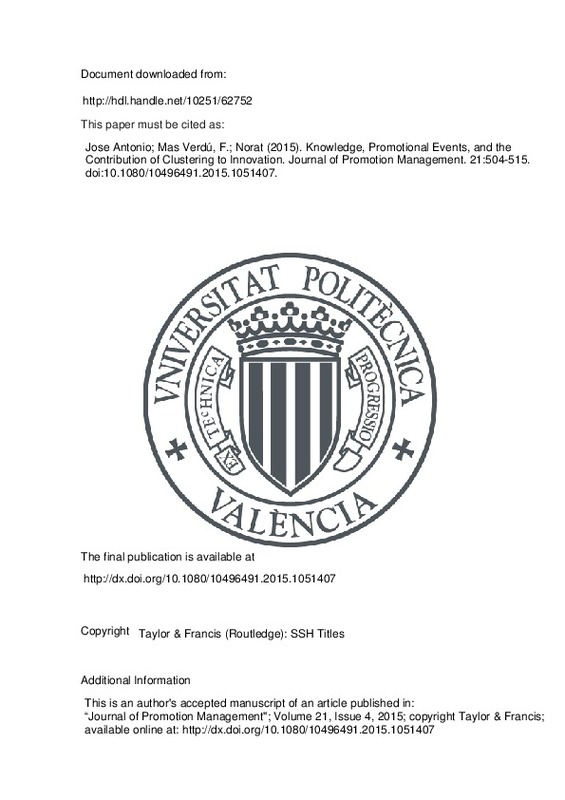Asheim, B. T., & Isaksen, A. (2002). The Journal of Technology Transfer, 27(1), 77-86. doi:10.1023/a:1013100704794
Autant-Bernard, C., Billand, P., Frachisse, D., & Massard, N. (2007). Social distance versus spatial distance in R&D cooperation: Empirical evidence from European collaboration choices in micro and nanotechnologies. Papers in Regional Science, 86(3), 495-519. doi:10.1111/j.1435-5957.2007.00132.x
Bathelt, H., Malmberg, A., & Maskell, P. (2004). Clusters and knowledge: local buzz, global pipelines and the process of knowledge creation. Progress in Human Geography, 28(1), 31-56. doi:10.1191/0309132504ph469oa
[+]
Asheim, B. T., & Isaksen, A. (2002). The Journal of Technology Transfer, 27(1), 77-86. doi:10.1023/a:1013100704794
Autant-Bernard, C., Billand, P., Frachisse, D., & Massard, N. (2007). Social distance versus spatial distance in R&D cooperation: Empirical evidence from European collaboration choices in micro and nanotechnologies. Papers in Regional Science, 86(3), 495-519. doi:10.1111/j.1435-5957.2007.00132.x
Bathelt, H., Malmberg, A., & Maskell, P. (2004). Clusters and knowledge: local buzz, global pipelines and the process of knowledge creation. Progress in Human Geography, 28(1), 31-56. doi:10.1191/0309132504ph469oa
Bathelt, H., & Schuldt, N. (2008). Between Luminaires and Meat Grinders: International Trade Fairs as Temporary Clusters. Regional Studies, 42(6), 853-868. doi:10.1080/00343400701543298
Boschma, R. (2005). Proximity and Innovation: A Critical Assessment. Regional Studies, 39(1), 61-74. doi:10.1080/0034340052000320887
Cohen, W. M., & Levinthal, D. A. (1990). Absorptive Capacity: A New Perspective on Learning and Innovation. Administrative Science Quarterly, 35(1), 128. doi:10.2307/2393553
Geigenmüller, A. (2010). The role of virtual trade fairs in relationship value creation. Journal of Business & Industrial Marketing, 25(4), 284-292. doi:10.1108/08858621011038243
Giner, J. M., & María, M. J. S. (2002). ‘Territorial systems of small firms in Spain: an analysis of productive and organizational characteristics in industrial districts’. Entrepreneurship & Regional Development, 14(3), 211-228. doi:10.1080/08985620210136009
Giuliani, E., & Bell, M. (2005). The micro-determinants of meso-level learning and innovation: evidence from a Chilean wine cluster. Research Policy, 34(1), 47-68. doi:10.1016/j.respol.2004.10.008
Hervas-Oliver, J.-L., & Albors-Garrigos, J. (2008). The role of the firm’s internal and relational capabilities in clusters: when distance and embeddedness are not enough to explain innovation. Journal of Economic Geography, 9(2), 263-283. doi:10.1093/jeg/lbn033
Lagendijk, A., & Lorentzen, A. (2007). Proximity, Knowledge and Innovation in Peripheral Regions. On the Intersection between Geographical and Organizational Proximity. European Planning Studies, 15(4), 457-466. doi:10.1080/09654310601133260
Ling-yee, L. (2006). Relationship learning at trade shows: Its antecedents and consequences. Industrial Marketing Management, 35(2), 166-177. doi:10.1016/j.indmarman.2005.03.006
Lorentzen, A. (2007). The Geography of Knowledge Sourcing—A Case Study of Polish Manufacturing Enterprises. European Planning Studies, 15(4), 467-486. doi:10.1080/09654310601133252
Markusen, A. (1996). Sticky Places in Slippery Space: A Typology of Industrial Districts. Economic Geography, 72(3), 293. doi:10.2307/144402
McCann, B. T., & Folta, T. B. (2011). Performance differentials within geographic clusters. Journal of Business Venturing, 26(1), 104-123. doi:10.1016/j.jbusvent.2009.04.004
Palumbo, F., & Herbig, P. A. (2002). Trade Shows and Fairs. Journal of Promotion Management, 8(1), 93-108. doi:10.1300/j057v08n01_09
Preacher, K. J., Rucker, D. D., & Hayes, A. F. (2007). Addressing Moderated Mediation Hypotheses: Theory, Methods, and Prescriptions. Multivariate Behavioral Research, 42(1), 185-227. doi:10.1080/00273170701341316
Ramírez-Pasillas, M. (2008). Resituating Proximity and Knowledge Cross-fertilization in Clusters by Means of International Trade Fairs. European Planning Studies, 16(5), 643-663. doi:10.1080/09654310802049158
Ramírez-Pasillas, M. (2010). International trade fairs as amplifiers of permanent and temporary proximities in clusters. Entrepreneurship & Regional Development, 22(2), 155-187. doi:10.1080/08985620902815106
Rinallo, D., & Golfetto, F. (2011). Exploring the Knowledge Strategies of Temporary Cluster Organizers: A Longitudinal Study of the EU Fabric Industry Trade Shows (1986-2006). Economic Geography, 87(4), 453-476. doi:10.1111/j.1944-8287.2011.01127.x
Rychen, F., & Zimmermann, J.-B. (2008). Clusters in the Global Knowledge-based Economy: Knowledge Gatekeepers and Temporary Proximity. Regional Studies, 42(6), 767-776. doi:10.1080/00343400802088300
Tafesse, W., & Korneliussen, T. (2012). Managing Trade Show Campaigns: Why Managerial Responsibilities Matter? Journal of Promotion Management, 18(2), 236-253. doi:10.1080/10496491.2012.668434
Tanner, J. F., & Chonko, L. B. (2002). Using Trade Shows Throughout the Product Life Cycle. Journal of Promotion Management, 8(1), 109-125. doi:10.1300/j057v08n01_10
Torre, A. (2008). On the Role Played by Temporary Geographical Proximity in Knowledge Transmission. Regional Studies, 42(6), 869-889. doi:10.1080/00343400801922814
Wolfe, D. A., & Gertler, M. S. (2004). Clusters from the Inside and Out: Local Dynamics and Global Linkages. Urban Studies, 41(5-6), 1071-1093. doi:10.1080/00420980410001675832
Wood, E. H. (2009). Evaluating Event Marketing: Experience or Outcome? Journal of Promotion Management, 15(1-2), 247-268. doi:10.1080/10496490902892580
[-]







![[Cerrado]](/themes/UPV/images/candado.png)


